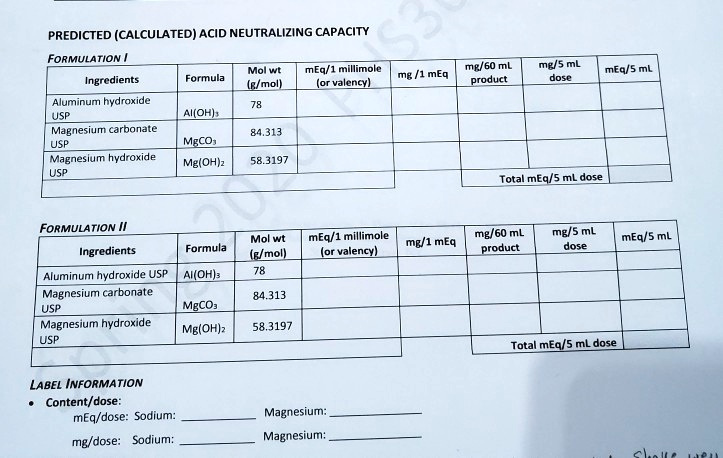In our quest to maintain a healthy environment, understanding the acid neutralizing capacity (ANC) of substances is crucial. This metric helps us determine the ability of a water body or soil to counteract acidity, which is vital for the health of ecosystems, agriculture, and even industrial processes. Calculating ANC is a fundamental skill for those in environmental science fields and beyond. This guide will demystify the process, providing easy-to-follow steps for anyone looking to measure the acid-buffering power of various samples, helping to preserve the delicate balance of our planet’s ecosystems.

Titration Method
Titration is a common laboratory method used to determine the acid neutralizing capacity of a solution. It measures how much of a standard solution of known concentration is required to neutralize the acidity of the sample.
Detailed Steps:
- Prepare the sample: Take the water sample whose ANC you wish to measure.
- Select an indicator: Choose an appropriate pH indicator that will change color at the desired endpoint of the neutralization reaction.
- Prepare the titrant: Use a standard solution, such as sodium hydroxide (NaOH), with a known concentration.
- Titrate the sample: Add the titrant to the sample gradually while constantly stirring until the indicator changes color, signifying that neutralization has occurred.
- Calculate ANC: Use the volume of titrant added and its concentration to calculate the ANC of the sample using the formula: ANC = (C × V × 50,000)/S where C is the concentration of the titrant (in meq/L), V is the volume of titrant used (in liters), and S is the sample volume (in liters).
Summary:
Titration offers a straightforward way to find the ANC, with the benefit of clear visual cues from the indicator. However, precision is crucial, as misreading the endpoint can lead to errors in the calculation.
Gran Plot Technique
The Gran plot technique is an analytical method to find the ANC with a graphical approach, often used when dealing with solutions of weak acids or when carbonate and bicarbonate ions are present.
Detailed Steps:
- Prepare the sample: Collect the sample and place it in a beaker.
- Titrate with a strong acid: Such as hydrochloric acid (HCl), and record the pH after each addition.
- Plot the data: Create a Gran plot by plotting the volume of acid added against the function f(V), derived from the pH measurements.
- Extrapolate ANC: Determine the volume of acid at which the curve intersects the volume axis, which corresponds to the ANC.
Summary:
The Gran plot technique is useful for samples where direct titration is unreliable. It is more complex and requires a good understanding of the plotting process, possibly presenting difficulties for novices.
pH Meter Method
Using a pH meter is another direct method of assessing the acid neutralizing capacity. It requires using a calibrated pH meter for accurate results.
Detailed Steps:
- Calibrate the pH meter: Ensure the device is properly calibrated according to the manufacturer’s instructions.
- Prepare the sample: Take your water sample and submerge the pH meter’s electrode.
- Record the initial pH: Document the initial pH reading of the sample.
- Add a known amount of acid: Such as HCl, to the sample and stir.
- Monitor the pH change: Continue adding acid in increments and recording the pH after each addition until you reach a pH that indicates neutralization.
- Calculate ANC: Based on the amount of acid added to change the pH to a predetermined neutral value, calculate the ANC using the pH titration curve.
Summary:
This method allows for continuous monitoring and is generally accurate. The disadvantage is the need for a calibrated pH meter and the potential for electronic error or operational mistakes.
Alkalinity Strips Method
Alkalinity test strips offer a simple and rapid means of estimating the ANC of water samples, suitable for field analysis or quick checks.
Detailed Steps:
- Collect the sample: Get a fresh sample of the water.
- Immerse a strip: Dip an alkalinity test strip into the sample.
- Wait and compare: Wait for the strip to change color, then match this color to a provided chart to estimate the ANC.
Summary:
Alkalinity strips are user-friendly and fast, but they only provide an approximation and can be inaccurate if samples have high turbidity or color that interferes with the color comparison.
Digital Alkalinity Tester
Digital alkalinity testers provide a balance of simplicity and precision and are becoming increasingly popular for on-site testing.
Detailed Steps:
- Calibrate the tester: Follow manufacturer’s guidelines to calibrate the digital tester.
- Test the sample: Place the tester’s sensor in the water sample and take the reading.
Summary:
Digital testers offer quick and straightforward readings, but their accuracy depends heavily on calibration, and they can be less versatile than other methods in measuring specific types of alkalinity.
Estimation by Calculation
Acid neutralizing capacity can be estimated through stoichiometric calculations if the composition of the sample is known and the assumption that the sample has a complete balance of cations and anions is true.
Detailed Steps:
- Obtain or calculate concentrations: Acquire or calculate the molar concentrations of all relevant anions and cations in the sample.
- Perform stoichiometric calculations: Apply stoichiometry to predict the ANC based on the known chemical reactions between the ions that contribute to alkalinity.
Summary:
This method is heavily reliant on accurate data and the assumption of complete ion balance, making it unsuitable for samples with unknown or complex compositions.
Back Titration
Back titration is useful when the sample has components that interfere with forward titration, allowing determination of ANC through a more indirect approach.
Detailed Steps:
- Over-titrate the sample: Add an excess of a standard acid solution to the sample.
- Back-titrate with a base: Determine the excess acid by titrating with a standard base solution.
- Calculate ANC: Use the difference in the amount of base and the original acid to calculate ANC.
Summary:
Back titration is helpful in tricky scenarios but introduces more complexity and potential for error in the process.
Colorimetric Method
Colorimetric methods determine ANC through color changes attributable to pH-sensitive dyes and are especially useful in automated systems.
Detailed Steps:
- Add a pH-sensitive dye: Introduce a colorimetric reagent to the sample.
- Measure absorbance or color intensity: Use a colorimeter or spectrophotometer to measure the color change indicating pH and, by extension, ANC.
Summary:
This method brings automation and repeatability but requires specialized equipment and can be influenced by sample color or turbidity.
Conductivity Method
Measuring the electrical conductivity of a sample can provide indirect data about ANC through correlations between ion concentration and conductivity.
Detailed Steps:
- Calibrate the conductivity meter: Use standard solutions to calibrate the instrument.
- Measure the sample’s conductivity: Submerge the sensor into the sample to get a reading.
- Correlate conductivity with ANC: Use known relationships between conductivity and ANC to estimate the sample’s neutralizing capacity.
Summary:
While rapid and non-destructive, conductivity measurements require calibration and are affected by temperature and composition variations.
Ion Chromatography (IC)
Ion chromatography separates ions in a sample, allowing for precise determination of the concentrations of constituents that affect ANC.
Detailed Steps:
- Prepare the IC system: Calibrate and set up the IC according to the manufacturer’s instructions.
- Introduce the sample: Inject the water sample into the IC system.
- Analyze the results: Use the chromatogram to determine the concentration of bicarbonate, carbonate, and other ions contributing to ANC.
Summary:
IC provides high accuracy and specificity but involves costly equipment and requires technical expertise, making it less accessible for non-specialists.
Conclusion
Calculating the acid neutralizing capacity is not just a laboratory exercise but a practice with profound implications for environmental health and management. The ten methods outlined each have their place depending on the context, resources, and precision required. Whether employing straightforward field-ready tests or detailed laboratory procedures, understanding the ANC of a sample empowers us to make informed decisions to protect our waterways and soils from the harmful effects of acidification.
FAQs
Q: Why is it important to measure acid neutralizing capacity?
A: Measuring ANC helps us understand a substance’s ability to buffer acids, which is fundamental in assessing and managing the health of aquatic systems and soils, as well as preventing corrosion in industrial contexts.
Q: Can I test ANC without specialized equipment?
A: Yes, there are simple methods such as alkalinity strips or digital testers that don’t require a full laboratory setup, though they might not be as accurate as more sophisticated methods.
Q: How does the presence of carbonates in water affect ANC measurements?
A: Carbonates and bicarbonates significantly contribute to a sample’s ANC. Depending on the method used, the presence of these ions can complicate the titration due to their buffering capacity, which is why methods like Gran plot technique or ion chromatography are sometimes preferred.








